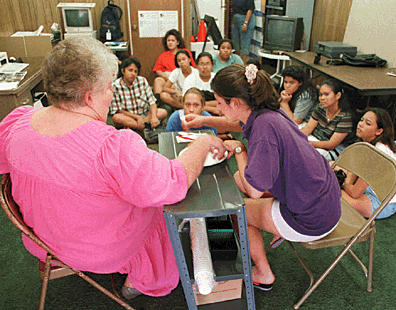'Kinda spooky when they say third-graders'
by Helen Altonn

Leeward YMCA community development project director Annette Yamaguchi, left, and Moana Delgado demonstrate proper eating manners to at-risk girls.
Photo by Dennis Oda, Star-Bulletin.

Leeward YMCA community development project director Annette Yamaguchi, left, and Moana Delgado demonstrate proper eating manners to at-risk girls.
Photo by Dennis Oda, Star-Bulletin.
"It's gone down from the seventh grade," said Yamaguchi, Leeward YMCA community development project director and Youth Gang Response System chairwoman.
"It's kinda spooky when they say third-graders."
Sgt. Rodney Goo, head of the gang detail in the police department's Juvenile Crime Prevention Division, said he's been getting calls for years from elementary schools about kids exhibiting gang characteristics.
"So it's not something new for us, but it is new for the community."
Police don't have manpower to cover all schools but go out "as needed" to talk to elementary school students, Goo said. "Although they don't fit into our definition of a gang, because they exhibit characteristics, we need to give them some information."
The principal of Ewa Elementary School, Irene Nakamoto, said that the school doesn't have a gang problem but that teachers became concerned after hearing children use certain words "or talk about it lke it's fashionable.
"According to teachers, it's like small talk. I think they (children) hear about it in the community or know of people (in gangs) in the community. It's good that it's coming to the surface, then we can deal with it," she said.
The school, noted for a statue of Abraham Lincoln in front, has 670 students, including 90 third-graders.
The teachers felt it wasn't too early in the third grade to make children aware that gang activities aren't "the right way of society," Nakamoto said.
Nakamoto believes strong gang activity has tapered off in the Ewa area in the past few years. "According to my sources in the community, they are not real formalized gangs - more like cliques."
She said Ewa Elementary's focus is on building self-esteem and social skills to direct children to be good citizens.